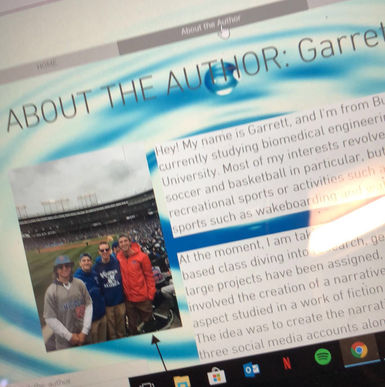
Short Assignment #1: Narrative Proposal

Production Calendar:
Promotional Materials (PDF)

This promotional piece (above) is the large promotional piece. while the other promotional piece (left) is smaller, use in profile pictures and mainly for social media.
P3 Process Report
The name of the narrative, a flash fiction series in this case, that I created was “Struggling for Strength.” In the creation of this narrative, there was a significant number of things I had to do in order to complete everything. Initially, I had to look back on the research on Antisocial Personality Disorder done in Project 2 so that I could accurately illustrate a character who owns such a mental illness. Secondly, I had to create a character who I felt I could develop easily, but a character whose development could be intriguingly portrayed. Finally, the most difficult part, was to find ideas of how to depict each story, the setting of those stories, the plot of the stories, and how to word each story so that I could make sure to keep them short, yet also leaving the reader wanting more. The intended audience of this narrative was for those who have or are having their lives touched by mental illness in any sort of manner as well as those who are interested on how mental illness such as Antisocial Personality Disorder (ASPD) can affect people throughout their lives. Some choices I made to ensure appeal to the audience was some dramatic scenes, particularly some emotional ones, which always seem to touch the heart of the reader, and I also felt that some scenes which included drastic, unnerving content would also catch the eye of the audience. The overall genre that I was trying to establish in the narrative was drama. To do so, I kept the characters as realistic as possible, a young boy who obviously ages as the stories go, his younger sister, his mother and father, all of which were conventional in how they acted throughout the narrative. Also, in most of the stories there was an aspect in which the thoughts of a character were directly displayed. The thoughts were relatively natural to the thought process I felt would an individual would naturally have to the situation they were in. This attempted to show the true emotions of each character so that the audience could relate, much like a drama should. Finally, I closed the narrative with a hard-hitting ending in which Jarod, the main character, commits murder, hoping to leave the audience with the impression that the battle with mental illness sometimes does not end happily. These types of genre conventions, realistic aspects and a hard-hit ending, were important to keep the dramatic genre of the narrative intact and effective in how the audience perceives the stories.
Some of the promotional pieces I made included posters and simple digital art imaging that focused on ideas of life with a mental disorder. One included a man who stands in front of what seems to be a massive iceberg, which shows representation of the enormous obstacle that is mental illness. The other shows a younger male and female embracing representing the necessity of support that those with mental illness need. Both images display the title clearly which allows the ideas to be portrayed simply by looking at the promotional images. To create and complete the promotional images, I used Canva, a digital artwork creation website which has just about anything one would need in making a promotional image, and all I needed was a computer. Canva provides templates, images, tools such as text, color, drawing utensils, and so on. As far as the process of the whole project, there was plenty of change since the initial creation of the flash fiction series. Initially, I had a few different characters and the narrative was somewhat all over the place. I cleaned it up and decided to focus on a single character, letting him develop throughout the series. Also, I had titled the flash fiction series “It’s All Mental” being that it all started with a mental illness that grew in negative ways. However, it wasn’t quite compelling enough for the substantial idea that mental illness brings along. I decided to change the title to “Struggling for Strength” to better depict what mental illness does to a person in almost every case. Managing time for this project played a huge roll in its completion. With ideas for ten different stories being needed, I tried to find around two or three every day. This allowed me to complete all ten in about four or five days, leaving a day or two to revise. With revision, I could eliminate unnecessary parts and make others more captivating. Personally, the most challenging aspect about composing Project #3 versus Project #2 was that I had to come up with original ideas myself. In Project #2, I had to research and I could use that research to help find a foundation for the paper. For Project #3, I needed to think of original ideas. It was as simple as that, yet extremely tough. If I could’ve given myself advice for Project #3, it would’ve been to write down every possible idea and eliminate from there. That would’ve sped up the process for me, a lot.
The three social media platforms I used to promote my narrative were Twitter, Instagram, and Snapchat. To draw attention to my narrative, I planned to display ‘sneak peaks’ of the narrative as well as the promotional art I made. I wanted to use a globally portrayed idea, mental illness, to draw readers to the accounts so they could be directed to the narrative and its ideas. Some hashtags I used were #ReachOut and #StopTheStigma, both of which are related primarily with mental illness. I followed around 130 people in an attempt to get them to follow back, and posted 100 times to Twitter, 70 times to Snapchat, and 50 times to Instagram for a total of 220 times. If my audience didn’t respond, I usually tweeted more interaction-based tweets, asking questions or using polls.
The composition processes of Project #2 and #3 varied almost completely. In composing Project #2, I had all the information I needed in front of me, I simply needed to establish two sides of a research-based paper, and then use the information to back up the sides. I needed to decide how to do so in an efficient manner. For Project #3, as I stated before, I was starting from scratch. I had so much less to work from, and everything I did had to be original. I began to just think on and on about how I could illustrate a story involving ASPD in an effective, enthralling manner. Project #2 was more of getting a point across in composition, using factual data and ideas while Project #3 was all about the adventure of the narrative, depicting in a far more creative perspective. The most challenging aspect, as stated before, was that Project #3 demanded almost everything come from my imagination and creativity, while Project #2 had so much information to use in its composition. I had to consider aspects of genre convention thoroughly as well because of their roll in narrative composition, while Project #2 lacked such because it was a research paper. Overall, if I had to give myself advice before Project #2 to ease the creation of Project #3, I would most likely have said not to use Antisocial Personality Disorder as the main focus just because of the higher prevalence of other mental illnesses. It wasn’t unbearably difficult, but the process of research for Project #2 and especially the ability to create stories for Project #3 would’ve been much easier with a mental illness that is more often seen in people.
Snapchat Promos:
Narrative Link:

Snapcode can be scanned to add snapchat account:
itsallmental213
Twitter Link:



























